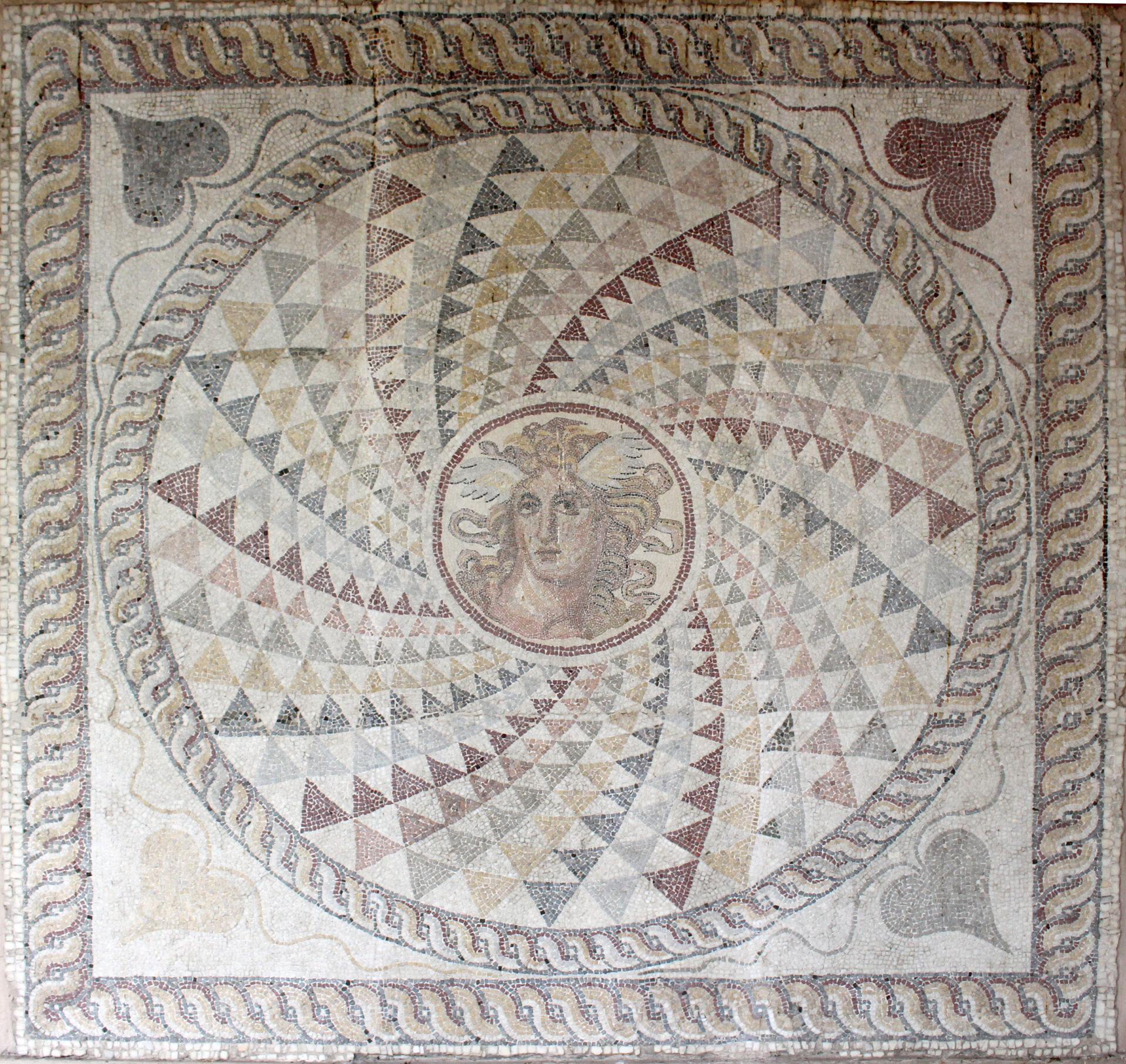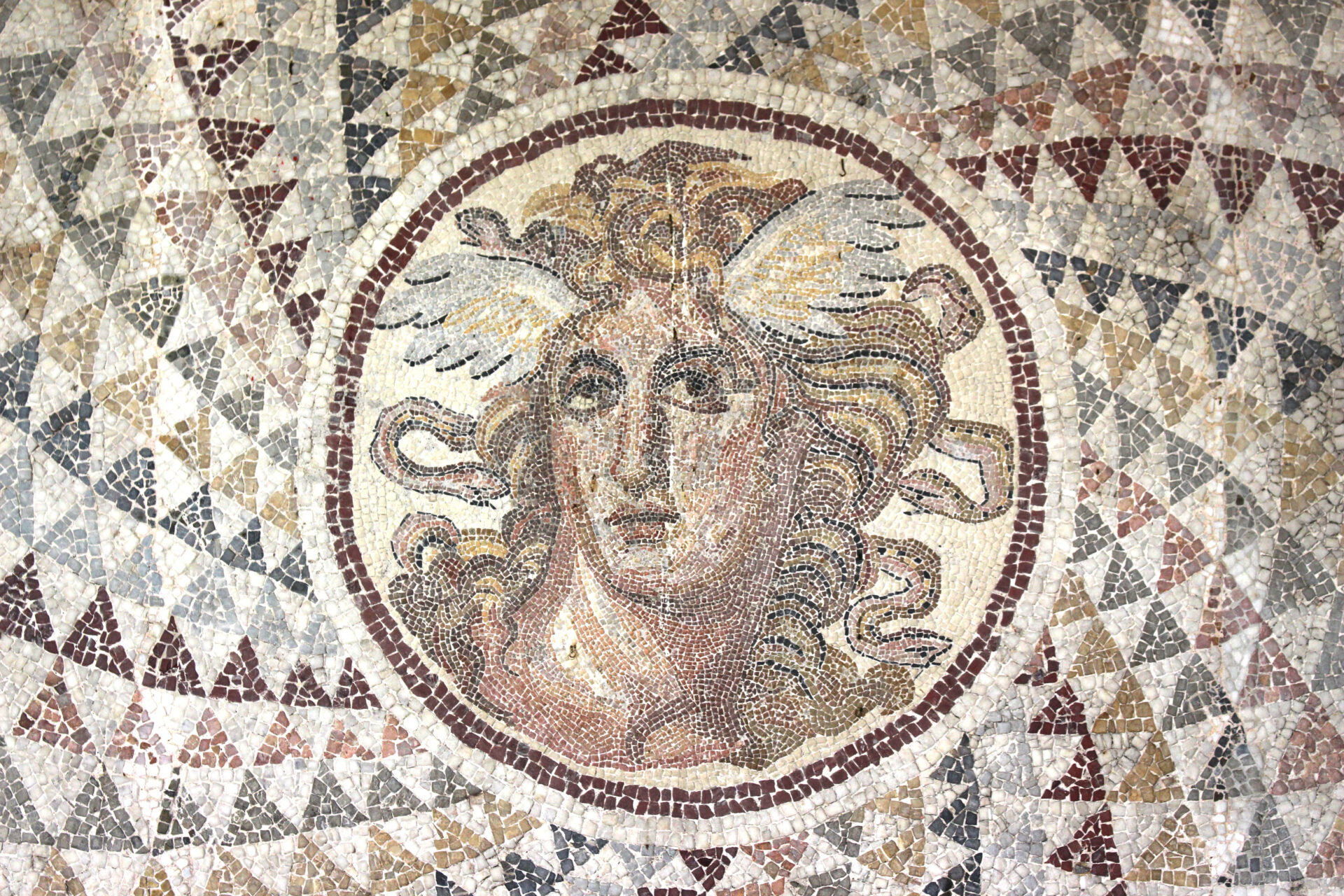Exhibit of the month
The fatal look of Medusa
Mosaic floor of a house depicting the head of Medusa
National Archaeological Museum
Sculpture Collection, inv. no. 16207
Provenace: Piraeus
Dimensions: Length: 3.08 m. Width: 3.00 m. Height of Medusa’s head 0.65 m.
Date: 2nd c. AD
Display location: Museum Atrium
Looking at the mosaic, the visitor’s gaze is drawn by the melancholy and beautiful face of Medusa, delicately and accurately made by a competent craftsman with much smaller tesserae than those used for the designs around it. The mosaic is decorated with a whirl pattern[1] consisting of triangles of different colors and sizes and, at the center, inside a medallion, the head of Medusa with a pair of wings next to her forehead and snakes in her hair. Surrounding this composition is a band with a cable pattern. Outside it, four large ivy leaves are placed at the corners of the quadrangular framing band, which is decorated with a larger cable pattern.
Taking a better look at Medusa’s face, and especially at the snakes springing from her hair, one realizes that she is far from harmless. Τhis realization leads us to the narration of her tragic story.
Medusa was the only mortal of the three Gorgons, daughters of the sea gods Phorkys and Keto (her two sisters were Stheno and Euryale). According to the myth she was the priestess of Athena and coupled with Poseidon, transformed into a horse, inside the temple of the goddess. Athena, infuriated by this sacrilege, turned Medusa into a hideous monster, which had snakes instead of hair, and the power to petrify anyone who looked at it in the face. Her end was grim: she was beheaded by the hero Perseus, aided by Athena, and immediately from her neck sprang Poseidon’s offspring, the winged horse Pegasos and the giant warrior Chrysaor. Her two immortal sisters pursued Perseus, who was saved thanks to Athena’s intervention. Medusa’s head, the famed Gorgoneion, was, finally, given to Athena by Perseus as a gift of thanks; she placed it as emblem on her aegis (a breastplate made from the skin of the Chimaera) and as blazon on her shield, as on the statuette of the Varvakeion Athena.
The first Gorgoneia that appear in Archaic art have monstrous features, which underline their daemonic nature: huge eyes, broad nose, open mouth with tongue hanging out, and dangerous teeth. However, from the Classical period onwards their human features prevail over the daemonic ones, and their ugly or exaggeratedly monstrous faces become humanized to such an extent that, finally, Medusa is transformed into a young attractive woman. The Gorgoneion becomes too good-looking to inspire fear. The combination of a beautiful but dangerous Medusa fascinated artists and led them to inspired masterful creations, such as the Strozzi Medusa and the Medusa Rondanini, whose prototype has been attributed, among others, to the famous Classical sculptor Pheidias.
[1] The whirl is geometrically composed of triangles of various alternate colors, and creates an optical illusion (trompe l’oeil): seen from afar it gives the impression of depth and quick movement, a vortex whose centre is the head of Medusa.
Dr Wanda Papaefthymiou
Select bibliography
LIMC IV, s.v. Gorgones Romanae p. 358, no. 176 [O. Paoletti]
Α. T. Philadelpheus, «Το Γοργόνειον», ΑΕphem 1894 p. 99-112, pl. 4
Ε. Buschor, Medusa Rondanini (Stuttgart 1958), p. 24, pl. 30-1
K. Karoglou, Dangerous Beauty, Medusa in Classical Art (New York 2018)




